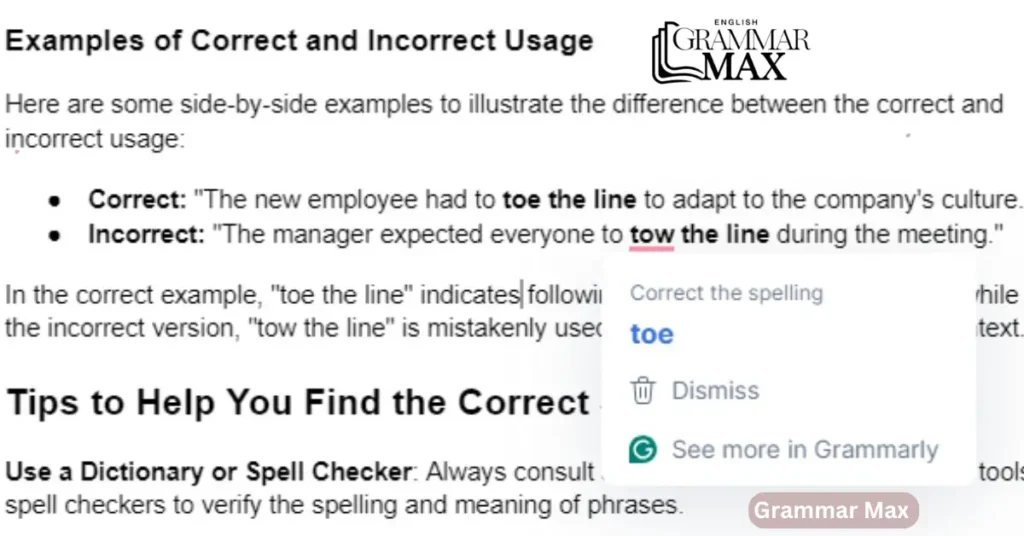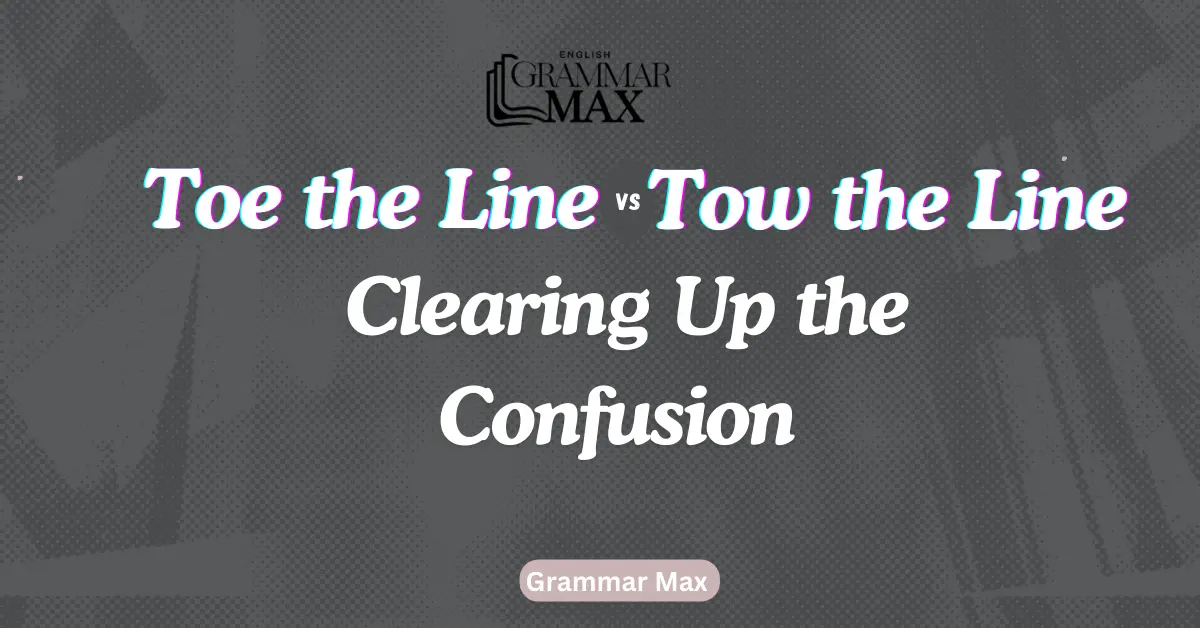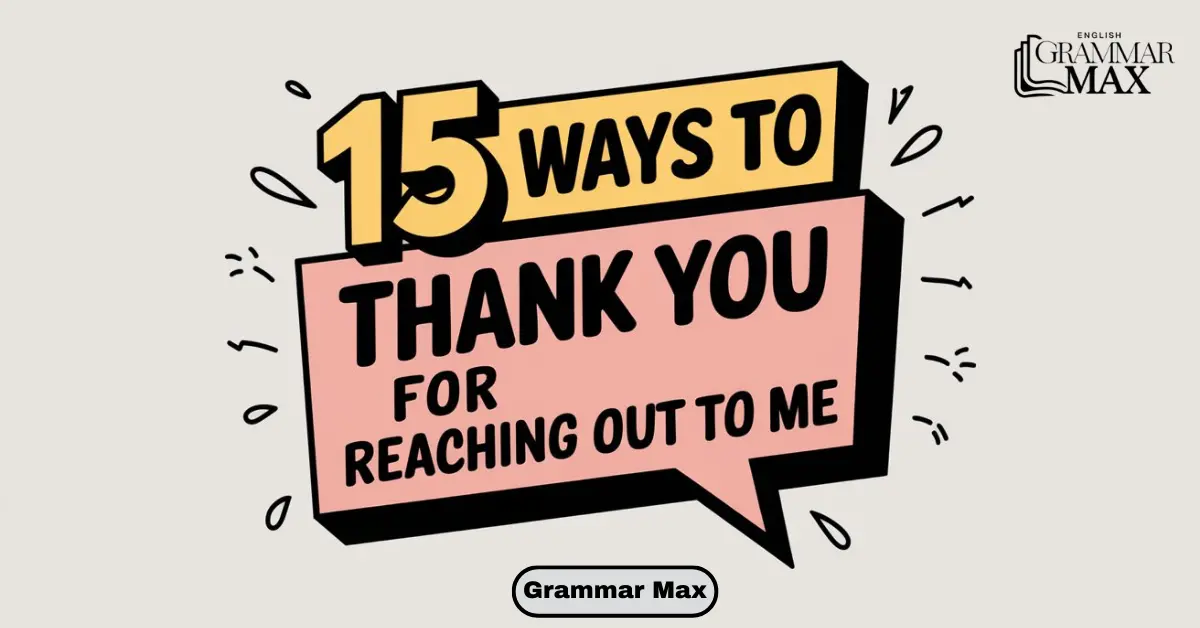“Toe the line” refers to following the rules or obeying a command. Yet, a common mistake people make is spelling it as “tow the line,” despite the two words having entirely different meanings.
Find out the correct usage of “toe the line,” why the confusion appears, and how to avoid this wordy error.
Toe the Line: Meaning and Etymology
The phrase “toe the line” means to conform to rules, expectations, or authority. If someone tells you to “toe the line,” they expect you to behave according to set standards or norms. In a workplace, social setting, or competitive environment, “toeing the line” implies obedience and discipline.
Toe the Line: The Etymology
This phrase originated in the early 1800s, with parallels in both sports and military exercises. During military formations, soldiers aligned themselves by placing their toes right on the center of a demarcating line on the ground, signifying readiness.
In sports, particularly footraces, athletes would place their toes on the starting line before the race began. This image of placing one’s toes on the line became an apt portrayal of abiding by rules or limits. Over time, the phrase evolved to symbolize following societal expectations and rules.
Toe the Line: Examples
To better understand how “toe the line” is used in everyday language, consider these examples:
- In the workplace: “In this company, you either toe the line or find another job.”
- In politics: “The senator had to toe the party line to maintain his position.”
- In education: “Students must toe the line when following school policies.”
These examples highlight the importance of adhering to established rules and guidelines.
Tow the Line: Definition and Common Mistake
Many people mistakenly use the phrase “tow the line.” However, this phrase does not have a meaningful connection to obedience or rule following. The word “tow” refers to pulling or dragging something, as in towing a car, which has no relevance in this context.
The confusion arises because “toe” and “tow” sound the same. This common error occurs frequently in writing, where readers may not immediately recognize the mistake if they don’t know the correct phrase.
Examples of Correct and Incorrect Usage
Here are examples that show the difference between the correct and incorrect usage:
- Correct: “The new employee had to toe the line to adapt to the company’s culture.”
- Incorrect: “The manager expected everyone to tow the line during the meeting.”
In the correct example, “toe the line” indicates following the company’s expectations. The incorrect example misuses “tow the line,” making no sense in context.

Tips to Help You Find the Correct Spelling
- Use a Dictionary or Spell Checker: Rely on a dictionary or a tool like Grammarly to catch common errors when writing.
- Look for Context: Understand how the phrase fits into the sentence to help clarify the correct form.
- Break Down the Words: Focus on each word’s meaning. For example, “toe” refers to part of your foot, which makes sense when thinking about standing in a line.
- Check Idioms and Common Phrases: Use idiom dictionaries or grammar websites to verify the correct version of popular expressions.
- Practice Reading: Exposure to well written material helps reinforce proper usage and spelling.
Why Knowing the Difference Matters
Understanding the difference between “toe the line” and “tow the line” is crucial for clear, professional communication. Using idioms incorrectly can confuse your audience or undermine your credibility. In formal writing such as business emails, articles, or academic papers precision in language builds trust and demonstrates command of the subject.
Awareness of common language pitfalls, like this one, can make you a better writer and speaker. Always doublecheck idiomatic expressions if you’re unsure of their correct usage.
Frequently Asked Questions
What Does “Tow the Line” Mean in Slang?
“Tow the line” holds no meaning in slang. It is a common mistake people make when they mean to say “toe the line.” “Tow” refers to pulling something, which doesn’t relate to following rules.
Is It “Toe the Line” or “Tow the Line”?
The correct phrase is “toe the line,” which means to conform to rules, expectations, or standards.
What Does “Toe the Line” Mean in Slang?
“Toe the line” in slang maintains its core meaning: to obey or conform to rules, norms, or authority.
Is It “Toe the Path” or “Tow the Path”?
Neither “toe the path” nor “tow the path” is a common idiom. The correct expression is “toe the line.“
Is It “Towing the Party Line” or “Toeing the Party Line”?
The correct phrase is “toeing the party line.” This means to conform to a political party’s policies or views without question.
Conclusion
Even if toe the line is used appropriately in context to refer to adjusting or adapting to set standards, the phrase tow the line is one which most people misuse with no figurative expression. Usage of this phrase in the right context helps enhance your communication skills as well as keep you away from one of the common language mix ups.
The next time you find yourself in a confrontational situation, where you know attention to the group is strongly encouraged, recall it is all about ‘toeing the line’ not ‘towing the line!

William Henry is a writer for Grammar Max, a blog that focuses on synonyms and phrases. He loves exploring the quirks of the English language and enjoys helping readers improve their vocabulary. William’s articles are easy to read, fun, and full of useful tips for anyone looking to better understand and use English. Whether you’re a student, a professional, or just someone interested in language, William’s writing on Grammar Max makes learning about words and their meanings simple and enjoyable.















